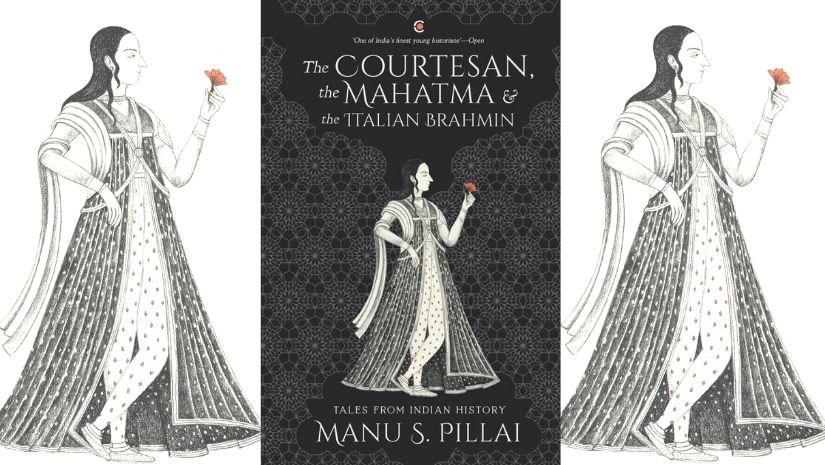Nationalism, politics, religion and that unquenchable thirst for power, all find their way into Manu Pillai’s latest work, The Courtesan, The Mahatma and The Italian Brahmin – a collection of anecdotes plucked from Indian history, from the lives of Maharajas and Begums, saints and soldiers. Pruned and formatted to fill a column, the essays that appear in this work of historical non-fiction were first published in Mint Lounge and other dailies such as The Hindu and The Hindustan Times, while their untrimmed drafts continued to be ‘filed away quietly’ by the author. These nuanced writings and thoroughly researched episodes from the lives of history’s instrumental figures – Queen Victoria, Wajid Ali Shah, Meerabai, Mahatma Gandhi, Dara Shukokh and others – form Pillai’s latest collection which offers a glimpse into a realm of victories and foibles that is India’s history. [caption id=“attachment_6863321” align=“alignnone” width=“825”]  Manu S. Pillai’s The Courtesan, The Mahatma and The Italian Brahmin.[/caption] Interestingly, through his writings, Pillai draws the reader into some excessively overt and ostentatious yet intriguing snippets from the past and in doing so establishes the appropriate context in which said events must be observed. Emphasising the need for ‘context,’ he points out, “It is the fashion of the day to hold yesterday’s rulers to today’s standards. Add a dose of communal antipathy, and you will find Islamic “tyrants” all over the place, as though they had a copyright on violence, while Hindu kings were all about virtue.” The truth is more complicated, he explains, because until 200 years ago, violence and power went hand in hand. Irrespective of being Hindu or Muslim, the ruler had to exert violence to exercise power and do so publicly. Tipu Sultan, for instance, Pillai says, stood up to the British on the one hand, and on the other desecrated temples in the lands of enemy kings that he conquered. He called Kerala Hindus infidels and yet employed many such “infidels” as ministers and functionaries in his court. He is regarded as a hero by a certain quarter even as some of his acts were horrific. Then how do we regard Tipu Sultan? Was he a brave, heroic soldier or a violent conqueror?
“Context is what helps us comprehend this and shows us how it is not a case of either-or. On the contrary, he was all of this at once.”
Pillai warns therefore that even as we take pride in our rich history, it should always be accompanied by self-awareness. It is crucial to acknowledge the context in which these actions were made possible. “Pride should not eclipse the realities of feudalism, caste, class, and other dynamics that shaped society.” * The Courtesan, The Mahatma and The Italian Brahmin, marks Pillai’s third work of historical non-fiction. The author who won the Sahitya Akademi Yuva Puraskar for his debut book, _The Ivory Throne_ , attributes his pursuit of this subject to the wealth of stories that are around us and the ‘few efforts we have made as a people to disseminate them.’ Among these are stories of ‘Telugu devotional literature, for instance, where God appears as a customer on his way to solicit the services of courtesans,’ ‘conflict between Hindu elites and their Islamic counterparts,’ and ‘women who smashed so many glass ceilings (and even obstacles made of tougher stuff).’ Through his work, Pillai suggests he is trying to “construct a bridge so that these tales can travel down, and we too can walk across and know our past more fully, in all its layered, exquisite complexity.” [caption id=“attachment_6863301” align=“alignnone” width=“825”]  Manu S. Pillai’s latest work marks his third book of historical non-fiction. Image credit: Satyajit V. Patil[/caption] Unlike his previous books, slightly weighty, elaborate ’tomes’ on the Majesties of Travancore, and his 2018 work Rebel Sultans: Deccan From Khilji to Shivaji, this collection is filled with crisp narratives sprawled across multiple periods in an attempt to “try and present interesting, engaging, significant topics, themes and figures from Indian history without overwhelming the reader.” In fact, in the essay, A Forgotten Indian Queen in Paris, the author describes his own travels from London to the French capital tracing the whereabouts of the graves of the baby princess and the last Begum of Awadh. After tracking down the cemetery in Paris, it was still a challenge to locate the Begum’s grave which is now identified by a plaque but until January 2018 lay unmarked, “a square plinth overgrown with weeds,” upon which people would sit to bum a smoke. Pillai’s columns are presented in two parts: histories from Before the Raj and Stories From The Raj. He writes about the devotion of saint Chokhamela and the spunk of Akbar’s wife Jodhabai or Mariam uz-Zamani (accounts differ as to her name) as well as the escapades of ‘Veer’ Savarkar and the British politic during the Imperial Rule. Of all of these, he concedes, he particularly enjoyed studying certain British personalities such as Lord Curzon in new perspectives, the story of the Muslim deity who exists in two south Indian temples and of the Brahmin woman who back in 1905, long before the #MeToo era ‘called out society’s hypocrisy in matters of sexuality and power.’ * Pillai, formerly Chief of Staff to MP Shashi Tharoor and to Lord Karan Bilimoria, CBD, writes heavily about rulers embroiled in political moves and countermoves and the inevitable bureaucratic messes that follow. However, the underlying motif of several of his essays is to scrutinise the place of tradition and caste hierarchy in history. What the author finds fascinating is “how custom and tradition are invented over time and in different places for political reasons.”
He points out, “Indeed, much of what we see as “timeless tradition” is actually not all that old, and was born out of specific contingencies at specific times.”
To explain this, he narrates the simultaneously earnest and comical tale of the Maharaja of Jaipur’s trip to England in 1802. Summoned by his political suzerain, the Maharaja whose Brahminical injunctions forbade him to cross the kalapani (sea) was in quite a conundrum about his overseas travel, until a solution presented itself. His travel arrangements: “The King carries with him thousands of litres of Ganga water, his bed is placed on soil from Jaipur so that “technically” he is on Indian soil; and with him travels his family deity – he is merely “following” God who is headed abroad!” The story exemplifies the monarch’s way of negotiating change on his own terms, the larger message being that tradition is hardly immutable, it has changed in the past, and it must change with time if it is to survive. The author also notes that from the very beginning caste oppression had sparked protests. “Often these were couched in devotional language and the vocabulary of faith, but caste was always opposed from below and always imposed by those above.” “What I wanted to show, through the stories of Basava and Chokhamela for instance, was that caste was never “accepted” by many important and original Indian thinkers.” Furthermore, on his essay about Sati Dana Suramu, a play designed as a parody of social conventions, he explains that we often put the heroes of history on a pedestal. We “have this sense often that people in the past were all noble, always guided by religion, orthodox, pure.” But historically, they too had a sense of humour and the ability to critique and lampoon. They would question social norms and were even capable of positively flouting them. They had their own share of weaknesses, strengths, flaws and obduracies. He states that laying these contradictions bare is a deliberate attempt to show that “we have to understand history, not sit in judgment over it.” Pillai’s book offers a thoroughly engrossing read of personalities featured prominently in history textbooks or revealed only in footnotes in their various shades. Their choices, mistakes and accomplishments offer a rather grandiose picture of India’s past and of the flagrant rule of one dynasty after another as history navigated the tides of change. Manu S Pillai’s The Courtesan, The Mahatma and The Italian Brahmin has been published by Context/Westland


)
)
)
)
)
)
)
)
)



